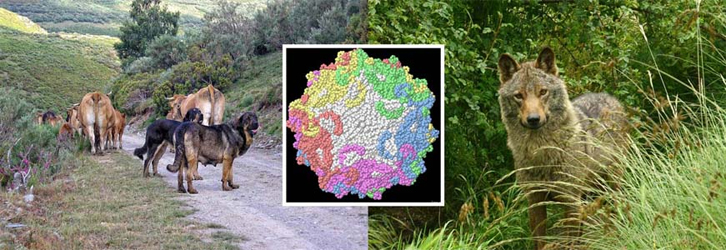Wildlife inhabiting human-dominated landscapes is at risk of pathogen spill-over from domestic species. With the aim of gaining knowledge in the dynamics of viral infections in Iberian wolves living in anthropized landscapes of northern Spain, between 2010 and 2013 the samples of 54 wolves were analysed by serology and polymerase chain reaction (PCR) for exposure to four pathogenic canine viruses: canine distemper virus (CDV), canine parvovirus-2 (CPV), canine adenovirus 1 and 2 (CAV-1 and CAV-2) and canine herpesvirus. Overall, 76% of the studied wolves presented evidence of exposure to CPV and 75% to CAV. The first detection of CAV-2 infection in a wild carnivore was reported. CPV/CAV-1 co-infection occurred in 51% of the wolves. The probability of wolf exposure to CPV was positively and significantly correlated with farm density in a buffer zone around the place where the wolf was found, indicating that rural dogs might be the origin of CPV infecting wolves. CPV and CAV-1 appear to be enzootic in the Iberian wolf population, which is supported by the absence of seasonal and inter-annual variations in the proportion of positive samples detected. However, while CPV may depend on periodical introductions by dogs, CAV-1 may be maintained within the wolf population. All wolves were negative for exposure to CDV and CHV. The absence of acquired immunity against CDV in this population may predispose it to an elevated rate of mortality in the event of a distemper spill-over via dogs. informacion[at]ebd.csic.es: Millán et al (2016) Patterns of exposure of Iberian wolves (Canis lupus) to canine viruses in human-dominated landscapes. EcoHealth EcoHealth 13, 123–134 DOI: 10.1007/s10393-015-1074-8
http://link.springer.com/article/10.1007/s10393-015-1074-8

 Las altas temperaturas están provocando que las lagunas y las marismas de Doñana pierdan agua rápidamente
Las altas temperaturas están provocando que las lagunas y las marismas de Doñana pierdan agua rápidamente




